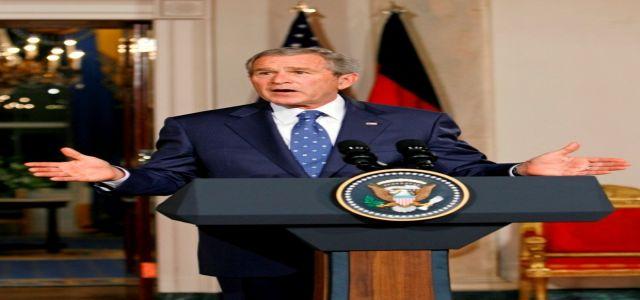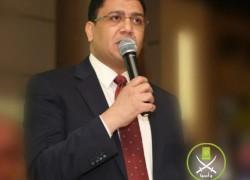- Reports
- January 13, 2008
- 8 minutes read
How The Arab Press Sees Bush Trip

This morning”s headline from President Bush”s trip to the Middle East: In a speech in Abu Dhabi, the President charged that Iran is threatening world security, and the United States and its Arab allies must join together to confront the danger. That”s OUR headline from the president”s address. How was it covered by the media over there? Mark Phillips has been looking at the world through their eyes.
The President of the United States arrives in the Middle East saying he”s trying to make peace one more time. At home, in a week of big political news, the story fights for airtime.
But in the Middle East, on the growing galaxy of state and independent television channels, it was “all Bush, all the time.” And, depending what you were watching, you could have been forgiven for wondering if what you were seeing was the same event.
If beauty is in the eye of the beholder, so is news.
In Israel, the President”s visit was portrayed as a belated effort to shore up the tentative peace-making efforts of two weak leaders – Israeli Prime Minister Ehud Olmert and Palestinian President Mahmoud Abbas.
Within the Palestinian Territories, it was reported either as a push for statehood … or a cover-up for oppression.
And if you were watching Syrian TV as President Bush arrived in Israel, you could even have been confused as to where exactly he was.
“George Bush visits the Palestinian Occupied Territories,” they announced, where they said, “He ignored the daily aggression and terrorism of the occupying forces.”
Hisham Melhem works in the new growing world Arab media.
“The media landscape has changed radically in a revolutionary way,” he said. “Today we have more than 250 satellite television stations, we have 19 new radio stations in the last few years.
“We have a different media reality that is taking shape in the Arab world, and the powers-that-be cannot ignore it.”
In an office in Beirut, Lebanese analysts track the content of the editorial riot that media outlets in the Middle East have become. And there”s little mystery, Jihad Bitar says, where those conflicting voices are coming from.
“It really depends on the channel”s political backing. You know, in the Arab world, the main news channels, you have Al Jazeera, which is owned by the Qatari government. You have Al Arabiya, which is owned by Saudi interests. Big, big differences.”
Differences reflected from the moment the president touched down.
“Al Jazeera, to give you an example, when George Bush arrived, they had a split-screen, divided in two,” Bitar explained. “George Bush was on the right, and on the left you had protesters in Gaza, people protesting George Bush”s visit. They were trying to show that people don”t want this. Arabyia tried to be more, sort of ambiguous coverage, which basically reflects Saudi Arabia”s official position. They were saying, “Okay, Bush probably is serious about peace. Before he leaves office he wants a peace agreement to be signed between the Israelis and the Arabs.””
If the politics of the Middle East have never been simple, the portrayal of them, at least, used to be predictable. TV stations, newspapers and commentators toed their government”s line. But now, as the market has fragmented, so has the coverage.
Abdul Bari-Atwan edits an Arabic newspaper in London that is read throughout the Middle East.
“If you look at previous trips of American leaders to the region and compare to this trip, you will find a huge difference,” Bari-Atwan said. “Before, it used to be one-sided media, the governmental media. But now you can there are independent media outlets there. You have Hamas which has its satellite channel, you have Hezbollah which has Al Manar satellite channel, you have Syrian satellite channels, you have also independent opposition channels in Egypt, you have independent voices in Lebanon. It”s a jungle out there.”
And the law of the jungle takes the form of conflict by TV proxy. Palestinian President Abbas” meetings with President Bush were covered like an encounter between heads of state on Abbas” Fatah faction-controlled TV.
But Abbas” blood enemies in the Hamas movement in Gaza had a very different take: There was no hopeful talk on their channel of a two-state solution with an Israeli partner. Instead, this headline at the top of their coverage:
“ON THE FIRST DAY OF BUSH”S VISIT TO THE REGION, 3 PALESTINIANS MARTYRS IN GAZA, INCLUDING A WOMAN AND A CHILD … KILLED IN ISRAELI SHELLING OF NORTHERN GAZA.”
Hannan Ashrawi has long been a major player in Palestinian politics.
“The Hamas coverage, it”s extremely hostile, and negative,” Ashrawi said. “The official news media is trying very hard to present this as a new era in Pal-American relations, as a period of promise, so you have very selective, often quite biased coverage in this part of the world.”
The coverage may be biased and linked to broader agendas, but it does often share a common perspective. There are givens.
Marc Lynch teaches political science at George Washington University and writes a blog on the Arab media.
“President Bush is swimming upstream against a very deep reservoir of suspicion, hosility and mistrust,” he said.
“The dominant narrative, the dominant frame in the Arab media, is still about the huge gap between what the president says and what”s actually happening on the ground,” Lynch said. “And so you get much more coverage in the Arab media of the expansion of settlements, and a lot more coverage of the Hamas/Fatah ongoing political standoff.”
The Israeli media are similarly pessimistic about the President”s mission, says Israeli journalist Avi Shavit.
“There is almost a tragic feeling to it, “Shavit said. “Both because of the failure of President Bush in transforming the region he wanted so much to transform, and because the result of that failed attempt is a growing feeling that America is losing its old mettle, or strong power over the region, and this is a concern shared by all.”
And then – Iran. During a week that saw conflicting versions released in Washington and Tehran of the encounter between Iranian gunboats and U.S. warships in the Gulf, the Iranians were also giving a different spin to President Bush”s trip.
Tehran”s Arabic channel, beamed throughout the Middle East, was on the streets of Ramallah while the President was in town, focusing on dissent.
And that”s what its viewers saw. Iran”s view of the U.S. President, says CBS News analyst Reza Aslan, is a lot like the U.S. view of President Ahmadinejad.
“The Iranian media sees the president of the United States as an out-of-control religious fanatic, pretty much the same way that the American press sees the president of Iran,” Aslan said.
Peace may be as elusive as ever in the Middle East but a new discordant chorus of voices has grown up to join the debate. That may make things more confusing … but it may offer opportunities as well.
“I think the most remarkable aspect of this renaissance taking place within the Arab press is that now the United States has a multiplicity of voices and multiplicity of views to turn to really understand not what the Arab regimes want or think but what people on the Arab street think or want,” Aslan said.



